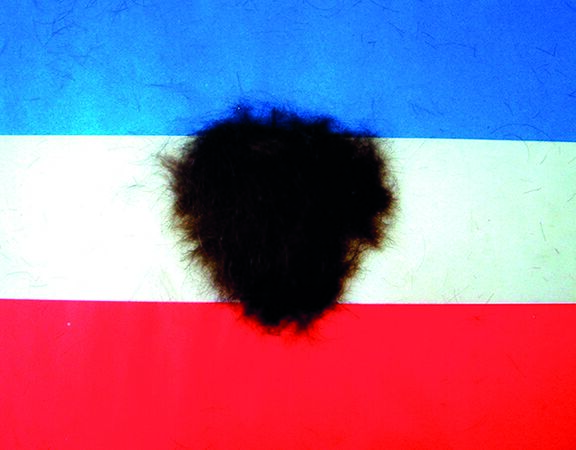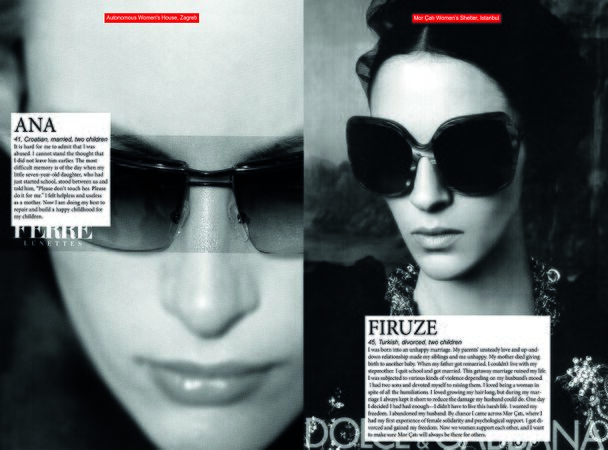Sanja Iveković
 Sanja Iveković, 1975. Photo: Dalibor Martinis. | |
| Collections | MoMA 19, Generali 14, Kontakt 8, Reina Sofia 3, Stedelijk 1, Macba 1 |
|---|---|
Sanja Iveković (6 January 1949, Zagreb) is a Croatian visual artist.
Sanja Iveković is an important figure, whose work is instrumental in our understanding of the reconfiguration of roles and gender in today’s art. She was one of the first artists on the Yugoslavian (now Croatian) scene to adopt a feminist standpoint in her work. Since 1989, she has used this perspective to tackle subjects such as the fall of the communist regime and the consequences of the triumph of capitalism and market economy, as well as their influence on living conditions, particularly those of women and the violence women have endured subsequently. Sanja Iveković studied at the Academy of Fine Arts in Zagreb from 1968 to 1971. She is part of a generation of artists that emerged after 1968 in Eastern European, working in fields as varied as video, film, installation, performance, interventions, photography (private and official), and collage – her series Double Life (1975) and Bitter Life (1975-1976) juxtapose publicity images and personal photographs. Her eminently critical work focuses on imagery and body politics. In her seminal performance Triangle (1979), she simulated masturbation on her balcony during Tito’s official visit to Zagreb until a policeman rang her doorbell. This initiative paved a transgressive path for many creators in the face of the ideological apparatus, as they were able to regain possession of the public space using the premise “the personal is political”.
Sanja Iveković has also analysed gender stereotypes perpetuated on television (General Alert: Soap Opera, 1995) and in magazines (Paper Women, 1976-1977). Since the 1980s, she has turned her attention to the challenges faced by democracy and politics by highlighting the construction mechanisms of collective memory and amnesia (Personal Cuts, 1982). The projects she worked on in and around the 2000s (Gen XX, 1997-2001; The Nada Dimić File, 2000-2002) were devoted to women in the Croatian resistance during the war against Nazism, whose names are now mostly forgotten. Her work has been the subject of several retrospectives. It was also featured at the 10th and 11th Istanbul Biennales (2007 and 2009); documenta 11 (2002), 12 (2007), and 13 (2012) in Kassel; and Manifesta 2 (1998) in Luxembourg. (Nataša Petrešin-Bachelez)
She lectured at the Center for Women's Studies in Zagreb from its beginning in 1994. She is a founder of Electra - The Women's Art Center Zagreb.
Gallery[edit]
Publications[edit]
- Structure – Book, Ljubljana: P.A.R.A.S.I.T.E., 2011, [100] sheets. Artist's book. [1]
Catalogues[edit]
- Sanja Iveković: Public Cuts, Ljubljana : Zavod P.A.R.A.S.I.T.E., 2006, 80 pp. Essay by Bojana Pejić. Published in conjunction with the exhibition Road Works in Ljubljana, at P74 Center and Gallery, Oct 2006; and in Velika Gorica, Croatia, at the Galzenica Gallery, Nov 2006.
- Sanja Iveković. Urgent Matters, Eindhoven: Van Abbemuseum, and Utrecht: BAK, 2009.
- Sanja Iveković. Practice Makes the Master, Łódź: Muzeum Sztuki, and Ha!Art Foundation, 2009. Exhibition. [2] (Polish)/(English)
- Sanja Iveković: Sweet Violence, ed. Roxana Marcoci, New York: Museum of Modern Art, 2011, 192 pp. Exhibition. Online companion.
- Sanja Iveković: Lady Rosa of Luxembourg, eds. Enrico Lunghi and Bojana Pejić, Luxembourg: Mudam Éditions, and Musée d’Art moderne Grand-Duc Jean, 2012. Exhibition.
- Sanja Iveković. Works of Heart (1974-2022), pref. WHW, intro. Zdenka Badovinac, Vienna: Kunsthalle Wien, 2022, 111 pp. Exhibition.
- Sanja Iveković. Weh dem, der sich vor Geistern fürchtet [Woe Betide Anyone Who Is Afraid of Ghosts], trans. Katharina Wolf-Grießhaber, Vienna: Kunsthalle Wien, 2022, 132 pp. Artist's book. Consists of around 50 poems written by Nera Šafarić-Iveković, mother of Sanja Iveković, as well as excerpts from her diary, facsimiles of letters she sent and received during her incarceration in Auschwitz, and numerous photographs from Sanja Iveković’s personal archive. With contributions by Miloš Đurđević and Sanja Iveković. Publisher. Exhibition. (Croatian)/(English)
Interviews[edit]
- Katarzyna Pabijanek, "'Women's House': Sanja Ivekovic Discusses Recent Projects (Interview)", ARTMargins, 20 Dec 2009.
Literature[edit]
- Klara Kemp-Welch, "Taking Women’s Rights Seriously?", Third Text 23:6, 2009 816-820.
- Carol Kino, "Croatia’s Monumental Provocateur", New York Times, Dec 2011.
- Ruth Noack, Sanja Iveković: "Triangle", London: Afterall, 2013, 106 pp, EPUB.
- Helena Reckitt (ed.), Sanja Iveković: Unknown Heroine - A Reader, London: Calvert 22, 2013. Based on the conference 23% organized in tandem with Ivekovic’s first UK retrospective Unknown Heroine at Calvert 22 and the South London Gallery in late 2012 and early 2013. [3]
- Lina Džuverović, "Curating ‘Unknown Heroine’: Sanja Iveković and Contemporary Feminisms", pp 8-21.
- Ivana Bago, "The Question of Female Guilt in Sanja Iveković's Art: from Yugoslav Beauty Pageants to Wartime Witch-Hunts", pp 62-87.
- Klara Kemp-Welch, "Night Cleaning at the Bank: Sanja Iveković’s Screen Tests for Invisible Women", in Thinking Art: Materialisms, Labours, Forms, ed. Peter Osborne, Kingston upon Thames, UK: CRMEP Books, 2020, pp 101-123.
See also[edit]
Links[edit]
- Profile on Electra Videocenter (archived)
- Brief biography on Tate, 2015.
- Retrospective exhibition, Kunsthalle Wien, 2022; MSU Zagreb, 2023. [4]






